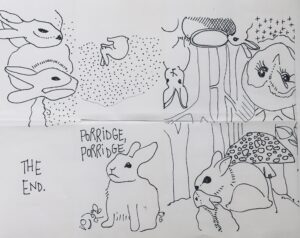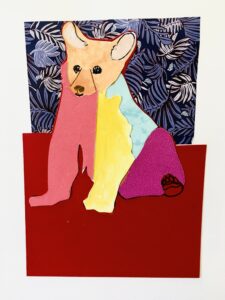
J. Riddell Matte (2020). Sad Poem. [mixed media]
Dear Reader,
The first thing I want to do is address the fact that, during my free inquiry, I never illustrated ‘Goldilocks and the Three Bears’. This felt like a failure for a hot minute, as though because I had not done what I set out to do my entire inquiry was a bust. A write off. A head-in-the-palm-of-your-hand type moment.
But I’ve thought about it a lot over the past couple of weeks, as the term comes to an end….and this is what I have realized;
I may not have illustrated the story that I had planned on illustrating but I did illustrate, narrate and make a video of ‘Porridge, Porridge’ by The Brothers Grimm. I took two illustration classes through the online education platform ‘Domestika’. I experimented with materials and I made art. I learned about the Public Domain and read many, many Brother’s Grimm stories through an online archive. I discovered that children’s books generally have 32 pages. I discovered new illustrator and looked at their incredible art and I practiced storyboarding. I participated in a zine workshop through the Vancouver Art Gallery with Cole Pauls and a drawing webinar, of the Southern Mountain Caribou, offered by the Sierra Club. I grew my personal learning network. I learned how to make screen recordings and voice over (this might be my tech super-power). I read children’s books. I blogged. I played Minecraft. I tried two on-line graphic novel programs, and I made a couple of short comic strips and a few graphic organizers with them. I learned from our guest speakers about privacy, inquiry based learning, accessibility and assessment.
Time during the pandemic has had the tendency to drag on (it’s not just me) and I’ve heard the saying ‘time is an illusion’ more, over these past three months, than at any other point in my life. But, for me, time has passed quickly in the mess of my free inquiry + the term. So, I guess I ran out of time and I didn’t get around to my big project, but those people who say ‘time is an illusion’ also say, ‘it’s not about the destination, it’s about the journey’ and although they say this in reference to Life, I have come to believe that it also applies to inquiry based learning.
One after noon, back in January, as I tried to figure out my free-inquiry and while waiting for middle-school to let out, my youngest son & I re-imagined ‘Goldilocks & the Three Bears”. I think that our story is kinda magic, and I am very much looking forward to illustrating it sometime in the near future.
Thank-you for being here.
Warmly,
Jen





